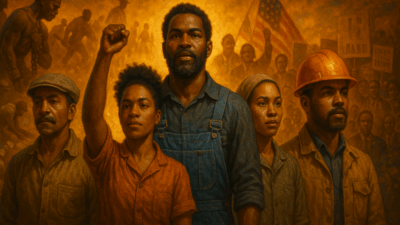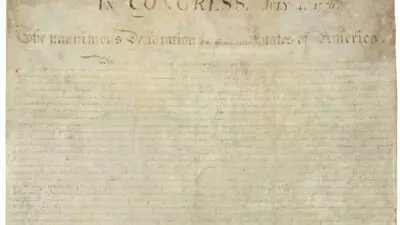There are lessons about labor rights we can learn from those who fought hard for them well before us, writes a Baltimore-area expert on the subject.

Speaking in support of organized labor in 1965, Rev. Dr. Martin Luther King, Jr. affirmed that the labor movement had been the “principal force that transformed misery and despair into hope and progress.”
More specifically, Black workers had been crucial figures in pushing the labor movement forward by taking audacious and direct action to advocate for their rights on the job and to be respected as working people.
Black workers recognizing and seizing their economic power is at the base of the liberation movements of our time.
The history of Black labor in the United States, with its origins in mass abductions and chattel slavery, is peculiar. Likewise, there is the long tradition of resistance.
Within this history, we can witness some of the most inhumane abuses of capitalism, but we can also witness models for how to fight back. In Baltimore specifically, we find remarkable instances of African American contributions to the labor movement.
A noteworthy example is that of Black caulkers in 19th-century Baltimore who carried out strikes and formed unions and cooperatives to demand fair wages and safe working conditions in the shipyards. They furthermore boldly acknowledged the racism and exclusion they faced within the national organized labor movement and advocated for interracial labor solidarity.
In the mid-19th century, Baltimore had an interesting labor situation. Ranked with New York and Philadelphia, the city was a major industrial metropolis and a leading trading center. As a result, there were various kinds of employment on a large scale, with jobs ranging from skilled to common laborer, especially in Baltimore’s shipyards.
One of those professions was caulking. For much of the early 19th century, free and enslaved Black Americans dominated the caulking trade. Frederick Douglass was leased to shipyard owners as a caulker before he escaped to freedom. Caulking was not easy work. It was a hot and challenging job that consisted of applying a sticky sealant to the sides and deck of wooden ships to keep them watertight; many avoided the trade if they had the luxury.
Those characterized as skilled and semi-skilled workers often joined with fellow tradesmen in local unions to protect their livelihood.
White unions excluded Black workers from membership, leading them to form their own labor associations. Indeed, the African American trade-union movement goes back further than many readily discern, with its roots visible before the Civil War.
For example, in 1838, Black workers formed the Caulkers Association, one of the first Black trade unions in the U.S., bargaining collectively with Baltimore’s shipyard owners to make significant gains in their working conditions. However, there was incredible discrimination on the Baltimore docks as immigrant white workers competed for the same jobs as Black workers.
Before and after the Civil War, white caulkers resorted to intimidation and violence to remove Black caulkers from the trade. In 1865, white caulkers went on strike and demanded that Black caulkers and dockers be fired before they returned to work, undermining the job security of Black workers after the Civil War. With the help of the city government and local police, management conceded, and more than 100 men were out of a job.
Among these men was Isaac Myers. Born to free parents in Baltimore in 1835, Myers, unwilling to surrender to his circumstances quietly, organized the Colored Caulkers’ Trade Union Society (CCTUS) of Baltimore in 1866. Myers, who was elected president, proposed that the union raise funds to purchase its own cooperative shipyard and railway.
They launched a campaign that raised $10,000 from Black individuals within and outside Baltimore, and they also secured a loan that enabled them to purchase a shipyard and railway, founding the Chesapeake Marine Railway and Dry Dock Company in 1866. This company employed both Black and white workers. Furthermore, the union, under the leadership of Myers, established a relationship with the White caulkers’ union, as both groups collaborated to address issues stemming from a common enemy.
While Myers was at the helm, the CCTUS became involved with unionism on a national level. Present at the annual convention of the National Labor Union (NLU) in Baltimore in 1869, Myers and other Black delegates pushed for the NLU to act decisively on the question of Black labor and open its doors to accept Black toilers.
At the convention, Myers advocated for solidarity, emphasizing that white and Black workers organize together for higher wages and a comfortable standard of living. He insisted that the union stand against racism and organize into an integrated union. After some deliberation, the NLU ultimately rejected Myers’ proposal and limited Black workers to separate labor organizations.
As a result, Black union leaders, including Myers, organized a national union for Black workers in 1869, often referred to as the Colored National Labor Union (CNLU). Myers served as the first president of the CNLU, with Frederick Douglass elected as president in 1872. The CNLU held its first convention in December 1869, and the union’s objective was to address the exclusion and marginalization of Black laborers from white labor unions, advocating for fair treatment, equal representation, and improved working conditions for Black Americans.
The legacy of the Colored Caulkers’ Trade Union Society and the Colored National Labor Union is a testament to the resilience and determination of Black laborers in their fight for equality, fair wages, and safer working conditions. Although Black workers had to organize independently due to persistent racism and discrimination in the organized labor movement, Black workers and their unions took up many opportunities to organize across racial lines as they understood that all workers suffered from similar conditions.
Today, we know that Black folks are unionized at a higher rate than any other ethnic or racial group, and working people are more diverse than ever. It is essential for workers of all races, ethnicities, nationalities, genders, etc., to understand that to build an equitable world, we must organize collectively, irrespective of our perceivable differences.
Our current economic system’s capacity to accommodate cruelty and brutality is vast.
However, our collective past is rich in models to consider for our current moment. We have examples that show us ways to protect working people and to challenge the unrestrained profit drive of capitalists.
Black history, and more specifically, Black-led labor struggles, make available to us tactics that get at the root of economic exploitation and racial oppression, which are used to divide the working class to the benefit of the oppressor.







